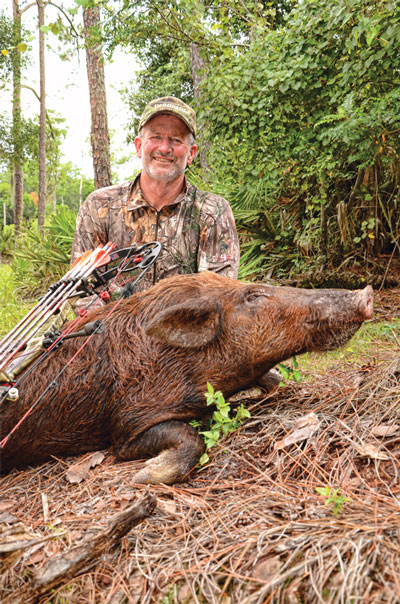In the early 1980s along California’s central coast, a new big-game hunting craze was just beginning. Though we didn’t know it at the time, the same thing was happening across much of America. That something was hunting wild boar.
Technically, the wild hogs we hunted then, as today, are not wild boar in a purely biological sense, nor are they North American natives. In fact, the first wild pigs in the United States originated solely from domestic stock brought to North America by early European explorers and settlers. Domestic hogs were first introduced in the 1500s to Florida by Spanish explorer Hernando deSoto as he searched for the mythical fountain of youth. In later years in California, the Spanish, moving north from Mexico, herded them along as a food source. In the centuries that followed, free-range livestock management practices and escapes from enclosures resulted in the establishment of wild domestic pig populations and promoted their spread. It was not until 1912 that true Russian wild boar were introduced, first at Hooper Bald, North Carolina, from where they soon were exported to other areas in Tennessee, Mississippi, Georgia, Florida, Louisiana, South Carolina, West Virginia and even New Hampshire. Some were also transported to the massive Hearst Ranch in Monterrey County, California. Though these early transplants were done in a controlled manner as people tried to keep them contained in large fenced “game-proof” areas (primarily so they could hunt them), many escaped. In areas where these true wild boar and strains of domestic hogs that also were living a free-range lifestyle met up, they interbred, giving us the hybrid feral swine we have in America today.
 Today, wild pigs have been reported in at least 45 states, with populations now existing as far north as Michigan, North Dakota and Oregon, though the real population hubs occur in the south: the Smoky Mountain region, Texas and coastal and central California as well as the Hawaiian islands. These range expansions over the past two-plus decades have occurred mostly due to illegal translocation of pigs by humans.
Today, wild pigs have been reported in at least 45 states, with populations now existing as far north as Michigan, North Dakota and Oregon, though the real population hubs occur in the south: the Smoky Mountain region, Texas and coastal and central California as well as the Hawaiian islands. These range expansions over the past two-plus decades have occurred mostly due to illegal translocation of pigs by humans.
I was living in southern California back in the 1980s and rode that initial wave of wild hog hunting. There was no season, no bag limit and no special tags required, and farmers and ranchers that would never consider letting a city slicker like me have permission to hunt deer on their land gladly allowed the killing of hogs. That’s because wild hogs tear up the habitat, decimate crops and foul water sources. I was so into it I even wrote a couple of books on the topic.
If there is a big-game animal more conducive to bowhunting, I have yet to find it. Because wild hogs breed year-round and prolifically, once they get started in an area it’s almost impossible to eradicate them – as evidenced by efforts in Texas to hammer them from helicopters with automatic weapons, or with the aid of spotlights at night. Hogs have very poor eyesight, making them relatively easy to stalk – as long as you respect their sense of smell – which is as good as any animal’s on the planet. Oh, and their hearing isn’t too shabby either. This makes hunting wild boar the best bowhunting practice of all. It is one thing to prepare for fall hunting seasons by tuning your bows and shooting countless arrows at target butts or even 3-D targets, and another thing entirely when you’re trying to make a perfect shot on an animal that never holds still and offers a relatively small vital target area. When it comes to becoming proficient as a bowhunter there is no substitute for actually killing animals, and you can legally kill more hogs in a few hunting trips than you can legally kill deer or other big-game at home in several years. You’ll also find hog hunts cost a fraction of what outfitters and landowners charge for other big-game species. As a bonus, it is also some of the finest meat you can put on your dinner table.
Wild hogs are also one of the toughest critters in North America. You have to hit them properly, through both lungs or the heart, or they will lead you on a long and often fruitless chase. You can cleanly kill them with the same archery tackle with which you hunt deer, though I have become a big fan of using mechanical broadheads that cut as big a hole as possible.
My latest hog hunting adventure occurred last summer in Florida, hunting with Hoppy Kempfer’s Osceola Outfitters (www.osceolaoutfitters.com; 407-957-3593) and Gary Cornum, marketing director of Easton, testing some prototype gear. Hoppy’s place is perfect for that, since his hog population is huge and we were able to hunt them both from treestands and by way of spot-and-stalk. I managed to slip inside 30 yards on two different young boars, made good shots and all was well.
Hunting wild boar is never “boaring.” It’s great fun, great practice and a great way to introduce novice bowhunters to the game. You can find a lot of information about wild hogs and hunting them online these days, including individual state game department websites. One good website for general information is http://www.invasivespeciesinfo.gov/animals/wildboar.shtml.






